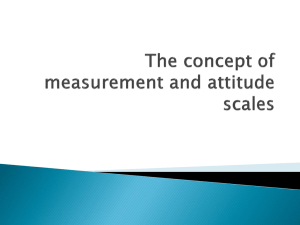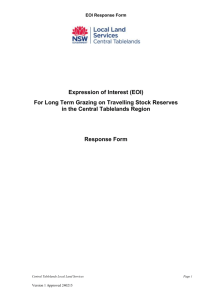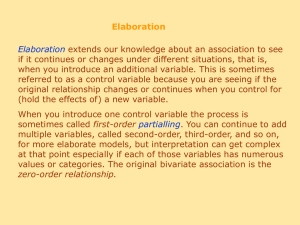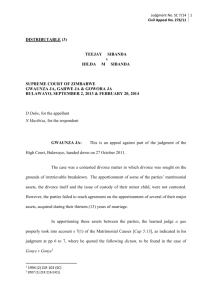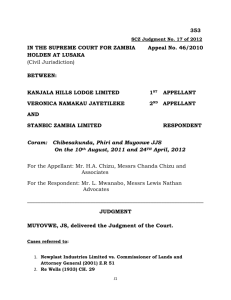Tlapana Makhetsela n Mamokete CIV APPL No9 02 15
advertisement
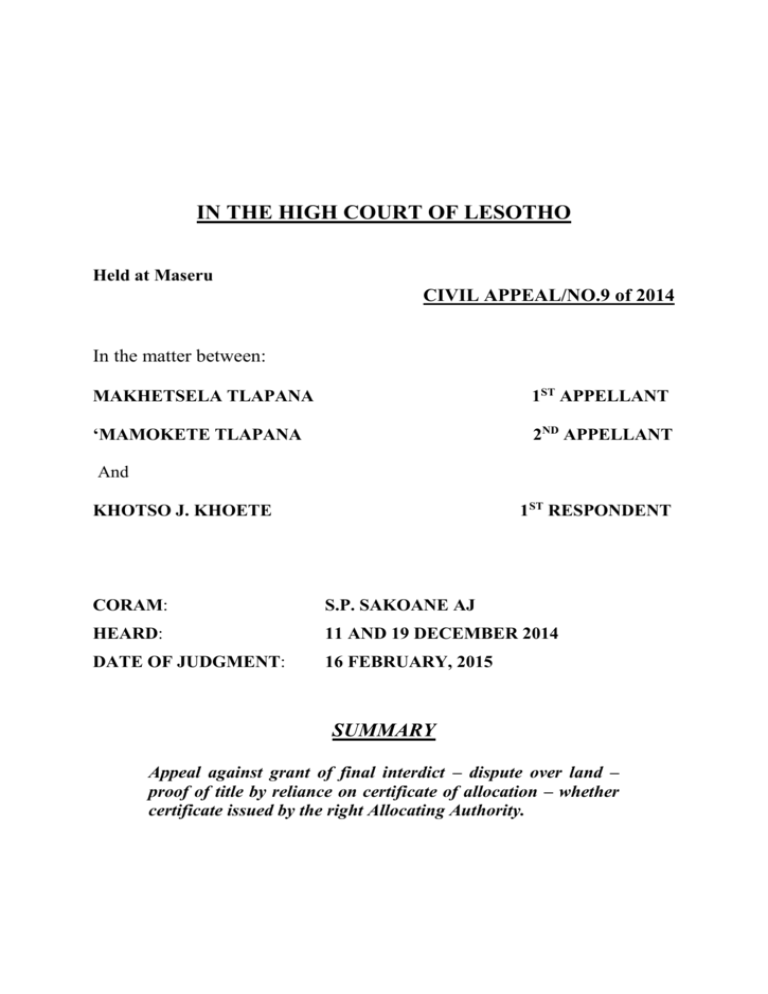
IN THE HIGH COURT OF LESOTHO Held at Maseru CIVIL APPEAL/NO.9 of 2014 In the matter between: MAKHETSELA TLAPANA 1ST APPELLANT ‘MAMOKETE TLAPANA 2ND APPELLANT And 1ST RESPONDENT KHOTSO J. KHOETE CORAM: S.P. SAKOANE AJ HEARD: 11 AND 19 DECEMBER 2014 DATE OF JUDGMENT: 16 FEBRUARY, 2015 SUMMARY Appeal against grant of final interdict – dispute over land – proof of title by reliance on certificate of allocation – whether certificate issued by the right Allocating Authority. ANNOTATIONS CITED CASES: Putsoane v. Lekatsu LAC (19990-94) 204 STATUTES: Land Act No.17 of 1979 Land (Amendment) Act No.6 of 1992 BOOKS: Prest C.B. (1996) The Law & Practice of Interdict (Juta) JUDGMENT A. INTRODUCTION [1] This appeal is against a judgment of the learned Chief Magistrate Central in which he granted an interdict preventing the appellants from interfering with the respondent’s use and enjoyment of a residential site situated at Thoteng ea Reisisi at Roma in the Maseru District. There are six grounds of appeal: “ 1. The learned Chief Magistrate erred and misdirected himself in deciding in favour of the Respondent that the Respondent actually owned rights to a site at Hata-Butle Thoteng ea Reisisi, Roma against the weight of evidence pointing to the contrary. 2 2. The court a quo erred and misdirected itself in holding that the Respondent held a valid title to land to a site at HataButle, Thoteng ea Reisisi, Roma on the basis of a Certificate of allocation (Form CC2) which stated categorically that applicant occupied land situated at Thoteng, Liphakoeng, Roma. 3. The court a quo erred and misdirected itself in holding that Respondent held a valid title to land in the Roma area on the basis of a (Form CC2) issued in terms of Section S(1), 10A and 17(1) of the Land Act 1979 when it was clear that such allocation would only be valid if issued in terms of section 24 of the Land Act 1979 as Roma was declared an urban area by Legal Notice No.14of 1980. 4. The court a quo erred and misdirected itself in rejecting the evidence of LEHATA TLAPANA that the land upon which the Respondent purports to have a site did not belong to the late Malepa but was bequeathed to the 2nd Appellant by 2nd Appellant’s late father. 5. The court a quo erred and misdirected itself in holding that on agreement purportedly entered into between the late Malepa and the Respondent constituted a valid grant of title to Respondent by the late Malepa. 6. The court a quo erred and misdirected itself in granting the Respondent an interdict under circumstances where the Respondent had not satisfied the requirements of an interdict.” 3 [2] The case sought to be made by the respondent in the court a quo was that the land in issue (i.e. a residential site) had been “reallocated” to him by the Land Allocating Authority pursuant to an agreement with the late Malepa Tlapana in return for a house built for him by the respondent. The respondent produced a certificate of allocation (Form CC2) exhibited and marked “A” date stamped 29 February 2000 by the Chief of Ha Mafefoane and Qhobosheaneng. [3] The appellants resisted the respondent’s case on the bases that: (a) The locality of the site referred to in the certificate of allocation (i.e. Thoteng Liphakoeng) is wrong as the correct one is Hata-Butle Thoteng ea Reisisi and not Thoteng, Liphakoeng. (b) The 2nd appellant was allocated the field at Thoteng ea Reisisi at Hata-Butle while the field at Liphakoeng was allocated to one Tšele Aloysius Tlapana. (c) The 2nd appellant is the lawful title holder with rights and interests which she has transferred (per “M.T.3” which is a Form CC2) to the 1st appellant as her son. 4 (d) These allocations were per a 1998 family resolution (exhibited and marked “M.T.1”) which was approved by the late Chief Maama Maama. [4] Given the evident dispute of facts, the court a quo heard oral evidence to resolve the disputes geared to answer what it called “a simple question as to who actually owns the rights to the site in question.” [5] In its judgment, the court a quo makes the following crucial findings: 1. Some of the signatories to the 1998 family resolutions had long died when such a meeting was held. 2. The certificate of allocation (M.T.3) in favour of 1st appellant was not printed on an unofficial form and was defective in that the date thereon was inserted even before the form could be printed by the Government Printer. 3. The evidence of the respondent was that his rights over the site flow from an agreement with the late Malepa is corroborated. An amendment was duly granted to amend his 5 papers to reflect that the site in dispute was situated at Thoteng ea Reisisi and not at Liphakoeng. 4. On balance of the evidence, the respondent has proved his case and the application was granted as prayed. B. SUBMISSIONS [6] Mr. Tlapana, for the appellants, contends that: 1. The court a quo made no findings of fact and yet reached conclusions that the appellants’ evidence was shattered by counterevidence. 2. Roma being an urban area, the allocation of land could only be valid if made by the designated allocating authority i.e. Urban Land Committee. Therefore, respondent’s reliance on Form CC2 (annexure ‘A’) is untenable as the grant is invalid. For this proposition, reliance is reposed on Putsoane v. Lekatsu LAC (1990-94) 204. [7] 6 Mr. Mohau, for the respondents, counters that: 1. It is significant that neither of the appellants testified in the court below and yet the respondent did and called witnesses in support thereof. 2. An appellate court will be reluctant to disturb findings which depend on credibility unless the court a quo had clearly misdirected itself in its reasoning. 3. A Form C constitutes prima facie proof of allocation and not the act of allocation itself. Any deficiency in it does not render the act of allocation done by the appropriate authority invalid. C. ANALYSIS [8] At the centre of this appeal is the question whether the findings of the court a quo in para 5 are sustainable on the facts and the law as to warrant the granting of an interdict. Put differently, did the respondent discharge the onus to warrant the granting of the order? [9] The requirements of a final interdict are: (a) A clear right. (b) An act of interference which constitutes an invasion of another’s right. 7 (c) Absence of any other satisfactory remedy with the same result for the protection. (See Prest C.B. (1996) The Law & Practice of Interdict (Juta) pp. 42-48) [10] The onus burdened the respondent to establish these requirements. The court a quo found as a fact that the respondent’s right to the site accrue from an agreement he had with the late Malepa in September 1998. Further, that the Development Council issued him with a certificate of allocation (Annexure “A”) – albeit with the location wrongly described as being at Thoteng, Liphakoeng instead of Thoteng ea Reisisi. [11] The said certificate of allocation is a Form CC2 which evidences allocation of a “Residential Land in a Rural Area”. The Form appears in the Third Schedule to the Land (Amendment) Act No.6 of 1992 pursuant to the amendment of sections 5 and 17 (1) of the Land Act, 1979 which now reads: “5(5) Where a decision is taken in respect of a residential allocation of land under Part II of this Act, the Allocating Authority shall issue a certificate of allocation (Form CC2 in the Third Schedule.” “17(1) The chairman of the Allocating Authority which grants a title to land shall issue or cause to be issued to the allottee a certificate which shall be either in Form “C1” or “C2” or “CC2” in the Third Schedule as appropriate.” 8 [12] Another important amendment to section 5 was the substitution of “Village Development Council” for “Land Committee” as the allocating authority for residential land in rural areas. [13] These amendments bring to the fore the validity or invalidity of Mr. Tlapana’s proposition that Roma having been declared an urban area in terms of the Second Schedule to the Land Act, 1979 and the Chairman of the Manonyane Community Council having so conceded, allocations to land to be valid ought to have been by the authority designated by law. In other words, the relevant Allocating Authority was the Urban Land Committee in terms of section 24 of the Land Act, 1979. [14] What does not appear from the record is whether the part of Roma where the disputed site is located is the urban part or the rural part. This enquiry is important because a reading of Legal Notice No.14 of 1980 which gives a description of the part of Roma declared as an urban area mentions two villages, namely, Maphotong and Ha Matobo. Hata-Butle and Liphakoeng are not mentioned. By inference therefore, it may be said that the latter two areas are in the rural area of Roma. Such an inference is strengthened by the evidence of the Chairman of the Manonyane Community Council (PW2) who testified, among others, that the Council’s 9 Register (Exhibit CX) for allocation of sites reflects that the respondent was allocated the site on 5/02/2000 and issued a Certificate of Allocation Form CC2. Further, that this Register is used in the registration of sites within rural areas. [15] The other certificate of allocation relied on by the appellants (M.T.3) was discredited under cross-examination as a fraudulent document. The court a quo heard and saw the witnesses who testified in relation to it and believed them. I do not find any basis to overturn this finding and none has been shown to me. As such, the appellants’ have no business interfering with respondent’s use and occupation of the land. There being no appeal against the amendment to rectify the locality of the site in Form CC2, the certificate of allocation remains intact. [16] On the balance of evidence, it does appear that the certificate of allocation Form CC2 was lawfully issued to the respondent in respect of land in a rural area of Roma. Accordingly, the respondent’s title to the land is intact as a valid grant of land. The Putsoane judgment is, therefore, not applicable on the facts of this case. 10 D. DISPOSITION [16] I then come to the conclusion that the court a quo rightly granted the relief sought and its judgment must be sustained. [17] The appeal is accordingly dismissed with costs. __________________ S.P. SAKOANE ACTING JUDGE For the Appellants: M.P. Tlapana For the Respondent: K.K. Mohau KC 11

